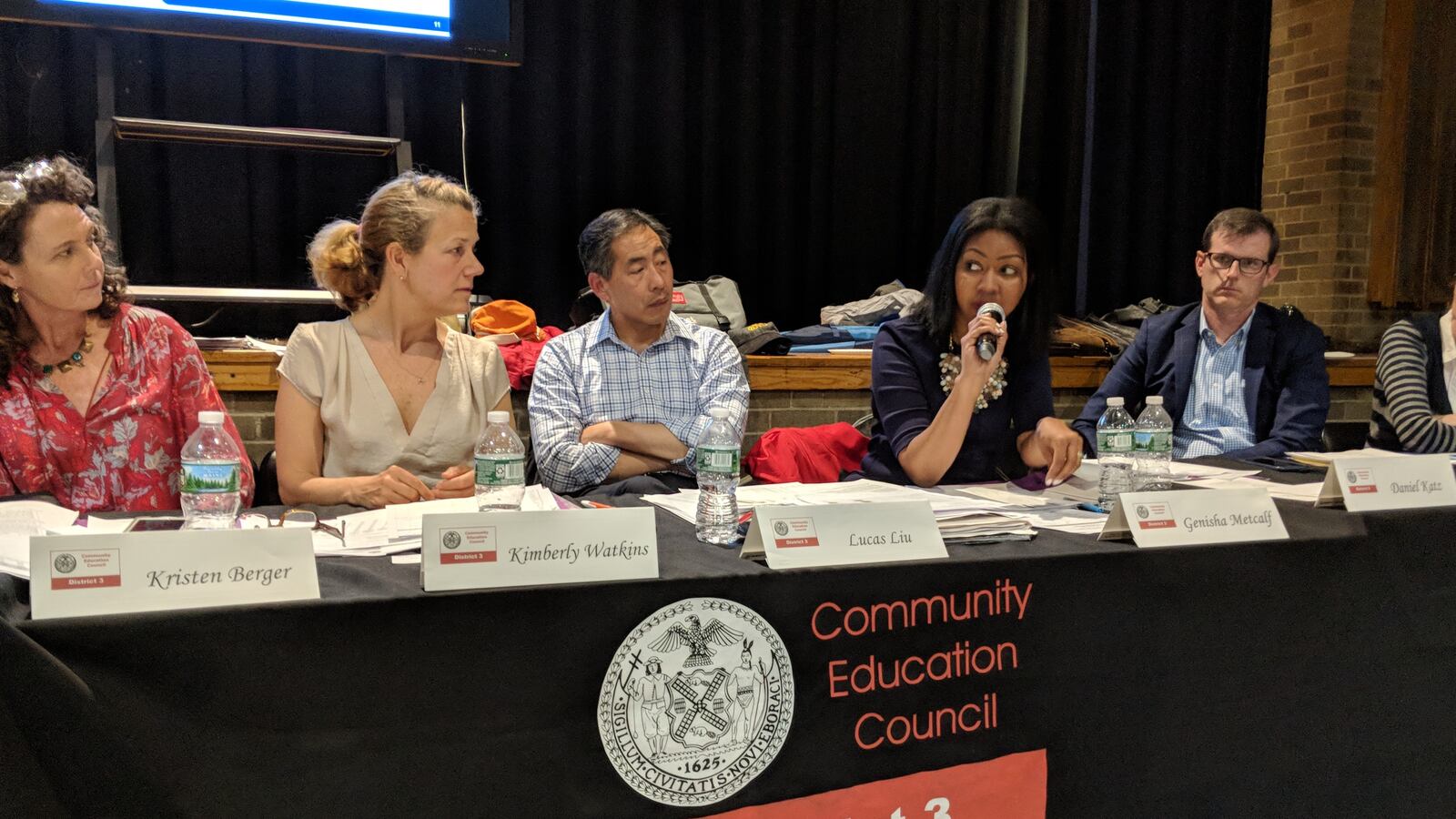Following controversy over a plan to desegregate Upper West Side and Harlem middle schools, the Department of Education unveiled two alternatives it hopes sit better with parents and educators.
At a Community Education Council hearing Wednesday night, the education department gave an overview of two alternatives to the initial proposal to integrate the district’s 16 middle schools, which angered some parents who were concerned it would shut their children out of sought-after schools.
The major difference between the initial proposal and the new plans is that they factor more than just state test scores into admissions offers — but it’s unclear whether the changes will quell the uproar over the integration effort, which has gained nationwide attention.
In both new plans, the agency aims to level the playing field for middle schoolers in the diverse but highly segregated west side Manhattan district.
In the first proposal, priority for 25 percent of middle school seats in every middle school in the district would be given to students who come from elementary schools with high economic needs and have low scores on both English and mathematics fourth grade state tests.
Out of that quarter of seats, 10 percent would be given to students in a group comprised of the very highest-need schools with the lowest-performing test scores; 15 percent of seats would be set aside for the next-highest need and lowest-performing group of students.
In the second proposal, priority for 25 percent of seats would be given to students based on a combination of their report cards and state test scores.
The hearing was much calmer than one several weeks ago, when a video went viral showing mostly white parents complaining that their children wouldn’t receive coveted middle school spots after excelling on state tests. The furor grew when Chancellor Richard Carranza tweeted the footage with a headline that said: “Wealthy white Manhattan parents angrily rant against plan to bring more black kids to their schools.” He has stood by his decision to share the footage, saying it “speaks for itself.”
On Wednesday, parents repeatedly told the CEC as well as District 3 Superintendent Ilene Altschul and other education department officials that the proposals, while addressing very high- and low-performing students and schools, leave other students behind.
In education department simulations of how each proposal would work, both plans resulted in double-digit increases in the number of low-performing students offered seats in three high performing schools: J.H.S. 54 Booker T. Washington, P.S. 245 The Computer School and West End Secondary School.
“Great, we’re doing a bigger push for diversity in some of the schools that have been highly sought after that historically fewer parents or students felt like they had as an option, but what are we doing to attract level 3 and level 4 students to [P.S. 180 Hugo Newman College Preparatory School]?” asked parent and CEC member Genisha Metcalf, referring to a school that fell roughly in the middle of the education department models for how each proposal would affect the district’s schools.
“Otherwise, we’re overcrowding four schools,” she added, over loud applause from the audience.
“Here’s the problem: Maybe instead of there being four desirable middle schools, there should be fifteen,” said parent Josh Kross, 41. “This is only going to create more problems.”
About a dozen parents asked questions of the plan during Wednesday’s hearing, asking how the plan would affect students with disabilities (it will not because those students will be prioritized first, regardless of the new plan, the education department said) and students who opt out of tests (students without state test scores will not be considered for the 25 percent of set-aside seats in the diversity plan, Altschul said).
They also brought very specific concerns such as whether or not potential changes to the plan would change the economic makeup of the school enough to threaten its Title I status, a federal designation that gives more funding to high-poverty schools.
“You didn’t have the answers … You didn’t do the math,” said parent Leslie Washington, whose daughter is in fourth grade at P.S. 242.
Though most who spoke up opposed the plan in some form, the proposal did have supporters in the room, including a group of principals and teachers. Cidalia Costa, a middle school teacher at West Prep Academy, said a plan to desegregate the area is “long overdue” to fix a system that’s been flawed for years.
“This plan is not for people who already have an advantage to get more advantage. So, I’m sorry, but I have to advocate for my students because they face a lot of challenges,” she said.
The Department of Education plans to make a decision about the proposal by the end of the school year, and changes would go into effect for the District 3 middle school class of 2019. A public comment period is up through May 29. The CEC is taking feedback through email at d3feedback@gmail.com.
After the meeting, Kristen Berger, chair of the CEC’s middle school committee, said she isn’t sure which proposal would be best. But she’s happy the conversation about measures to desegregate schools in the district is ongoing.
“It is a small fix, but it is a movement in the right direction,” she said of the middle school effort, adding that the group still needs to address system-wide issues including whether “all schools at all levels, elementary, and middle, are of good enough quality.”


